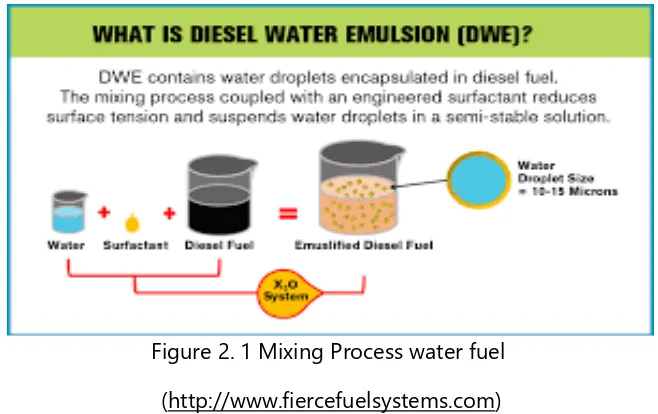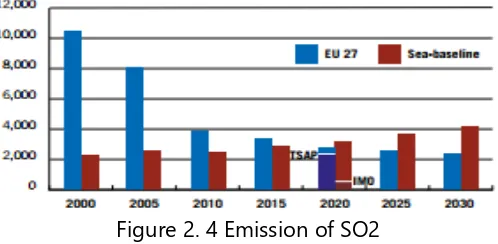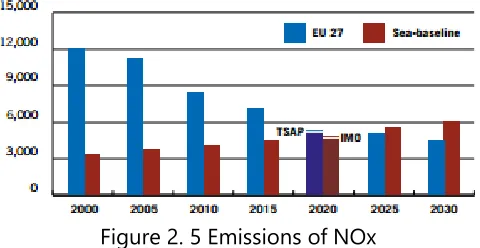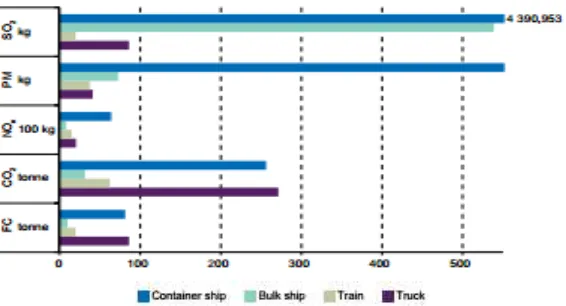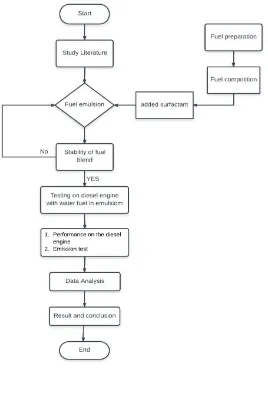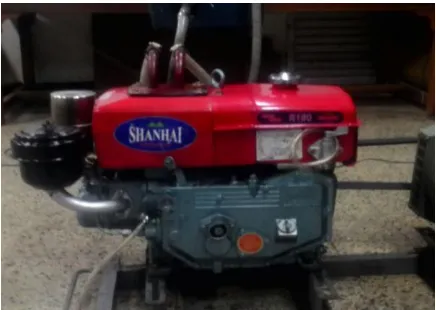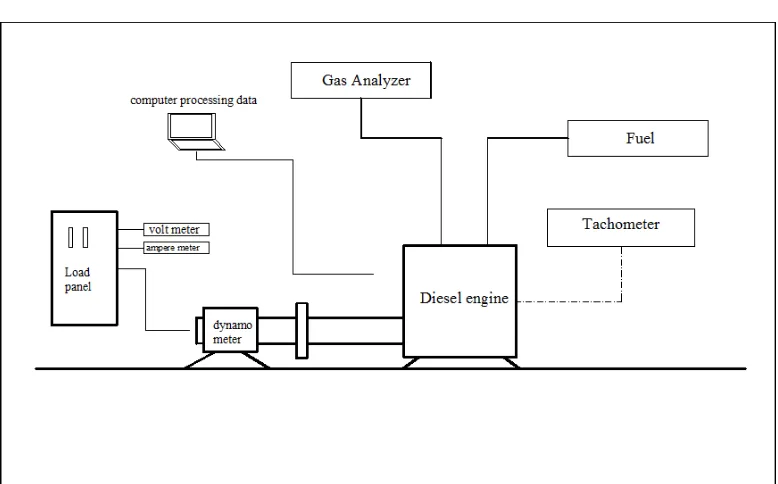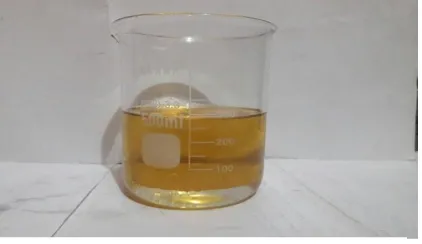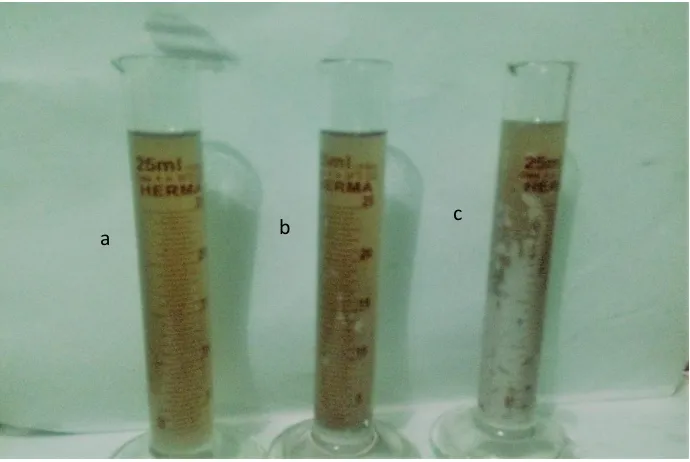BACHELOR THESIS (ME 141502)
Effect of The use of Water in Fuel Emulsion on Performance and
NOx on The Diesel Engine
NAUVAL PAHLEVI TAMBUNAN
NRP. 4213 101 039
Academic Supervisor 1
Beny Cahyono, ST, MT, Ph.D
Academic Supervisor 2
Ir. Aguk Zuhdi Muhammad Fathallah, M.Eng, Ph.D
DOUBLE DEGREE PROGRAM OF
MARINE ENGINEERING DEPARTMENT
FACULTY OF MARINE TECHNOLOGY
INSTITUT TEKNOLOGI SEPULUH NOPEMBER
SURABAYA
SKRIPSI (ME 141502)
Pengaruh Penggunaan Bahan Bakar Emulsi air pada Performa dan
NOx pada Mesin Diesel
NAUVAL PAHLEVI TAMBUNAN
NRP. 4213 101 039
Dosen Pembimbing 1
Beny Cahyono, ST, MT, Ph.D
Dosen Pembimbing 2
Ir. Aguk Zuhdi Muhammad Fathallah, M.Eng, Ph.D
PROGRAM GELAR GANDA
JURUSAN TEKNIK SISTEM PERKAPALAN
FAKULTAS TEKNOLOGI KELAUTAN
INSTITUT TEKNOLOGI SEPULUH NOPEMBER
SURABAYA
ii
iv
vi
vii
DECLARATION OF HONOR
I, who signed below hereby confirm that:
This final project report has written without any plagiarism act, and confirm consciously that all the data, concepts, design, references, and material in this report own by Marine Power Plant Laboratory (MPP) in department of Marine Engineering ITS which are the product of research study and reserve the right to use for further research study and its development.
Name : Nauval Pahlevi Tambunan
NRP : 42 13 101 039
Bachelor Thesis Title : Effect of The use of Water in Fuel Emulsion on
Performance and NOx on The Diesel Engine Department : Double Degree Marine Engineering
If there is plagiarism act in the future, I will fully responsible and
receive the penalty given by ITS and Hochschule Wismar according
to the regulation applied.
Surabaya, July 2017
viii
ix
Effect of The use of Water in Fuel Emulsion on Performance and NOx on
The Diesel Engine
Name : Nauval Pahlevi T
NRP : 42 13 101 039
Department : Double Degree Marine Engineering
Supervisor 1 :
Beny Cahyono, ST, MT, Ph.D
Supervisor 2 : Ir. Aguk Zuhdi Muhammad Fathallah, M.Eng, Ph.D
ABSTRACT
NOx one of the exhaust emissions is harmful to human health. Many methods can reduce NOx emission, one of them is water in fuel emulsion. By using experiment, research has been conducted in surfactant selection. The results of experiment show 4 surfactant, which is best used to the diesel engine is tween 80 and span 80. This experiment needs some water contents variation emulsifier with 10%, 15%, and 20%. In this different variation of water is very influential on performance and NOx emissions. Using water fuel emulsion of 10% in SFOC can increase 216,2 g/Kwh or 11.6% compared to Pertamina Dex of fuel. However, the water used in fuel emulsion of 15% and 20% in SFOC increased to compare 10% emulsion. The effect of water use in fuel emulsion can reduce NOx emission. Water in fuel emulsion can be decreased to 0.216 g/Kwh or 50.5%. Generally, the emission level of a diesel engine that has been using water in fuel emulsion can be improved until entering on Tier 3 specification of IMO rules.
x
xi
Pengaruh Penggunaan Bahan Bakar Emulsi air pada Performa and NOx
pada Mesin Diesel
Nama : Nauval Pahlevi T
NRP : 42 13 101 039
Departerment : Double Degree Marine Engineering
Dosen Pembimbing 1 :
Beny Cahyono, ST, MT, Ph.D
Dosen Pembimbing 2 : Ir. Aguk Zuhdi Muhammad Fathallah, M.Eng, Ph.D
ABSTRAK
NOx salah satu emisi gas buang yang berbahaya bagi kesehatan manusia. Banyak metode yang ditawarkan untuk mengurangi emisi NOx salah satunya adalah bahan bakar emulsi air. Dengan menggunakan percobaan, penelitian telah dilakukan pemilihan surfaktan. Hasil percobaan menunjukkan dari 4 surfaktan, yang baik digunakan untuk mesin diesel yaitu tween 80 dan span 80. Dalam percobaan ini diperlukan beberapa kandungan variasi air untuk pengemulsi terdiri dari 10%, 15%, dan 20%. Dalam variasi air yang berbeda ini sangat berpengaruh terhadap performa dan emisi NOx. Menggunakan emulsi bahan bakar air 10% di SFOC dapat meningkat 216,2 g / Kwh atau 11,6% dibanding bahan bakar Pertamina Dex. Namun, air yang digunakan dalam emulsi bahan bakar 15% dan 20% di SFOC meningkat untuk membandingkan emulsi 10%. Pengaruh pada penggunaan bahan bakar emulsi dapat mereduksi emisi NOx. Bahan bakar emulsi dapat menurun hingga 0,216 g / Kwh atau 50,5%. Umumnya, tingkat emisi mesin diesel yang telah menggunakan bahan bakar emulsi dapat ditingkatkan sampai masuk pada peraturan IMO spesifikasi Tier 3.
xii
xiii
PREFACE
Alhamdulillah, Praise to Allah Subhanahu wa ta’ala for the presence of plenty of mercy and his grace, so that the writer can complete the bachelor thesis with
the title of “
EFFECT OF THE USE OF WATER IN FUEL EMULSION ON
PERFORMANCE AND NOx ON THE DIESEL ENGINE
This Bachelor Thesis were submitted in order to comply with one of the requirements to obtain a Bachelor Degree in Department of Marine Engineering, Institut Teknologi Sepuluh Nopember
Also I would like to express my gratitude for those who always give their best support and attention:
1. My parents and sister, who always support through bad times and good times.
2. My 1st supervisor, Beny Cahyono, ST, MT, Ph.D for your great support, and attention.
3. My 2nd supervisor, Ir. Aguk Zuhdi Muhammad Fathallah, M.Eng, Ph.D for your great support, and attention.
4. Ir. Dwi Priyanta, MSE, as Double Degree Academic Advisor.
5. Dr. Badrus Zaman, S.T., M.T., as a Head Department of Marine Engineering.
6. Pak Semin, S.T., M.T., Ph.D, as a Secretary for Head Department of Marine Engineering.
7. Heri Febriantoro, Adhitya Wisnu Perdana, Gusma Hamdana Putra, Nilam Octaviani, and Suryo Abi Suroso for your ultimate support, and attention.
8. All lecturers and staff in Department of Marine Engineering who always give their best effort to support the program.
9. Bu Titin, who has given his recommendation to get the Gas Analyzer for experiment data
10.Pak nur and Leonardo Sitinjak, who always support me and share their knowledge.
11.Okky Mahardika, Sigit Purnama and Nova, who help me for experiment using diesel engine
xiv
13.All members of MPP to help this Bachelor Thesis.
xv
LIST OF CONTENT
DECLARATION OF HONOR ... vii
ABSTRACT ... ix
ABSTRAK ... xi
PREFACE ... xiii
LIST OF CONTENT ... xv
LIST OF FIGURE ... xvii
LIST OF TABLE ... xix
CHAPTER I INTRODUCTION ... 1
1.1 Background ... 1
1.2 Problem Statement ... 2
1.3 Research limitation ... 2
1.4 Research Objectives ... 2
1.5 Research Benefits ... 2
CHAPTER 2 LITERATURE REVIEW ... 3
2.1 State of The Art ... 3
2.2 Blending ... 4
2.3 History of internal combustion engines ... 5
2.4 Water Fuel Emulsion ... 6
2.5 Diesel engine performance ... 7
2.6 Rules and Regulation Emission ... 8
2.7 NOx Emissions Standards ... 11
CHAPTER III METHODOLOGY ... 13
3.1 General ... 13
3.2 Start ... 14
3.3 Study literature ... 14
3.4 Fuel preparation ... 14
3.5 Fuel emulsion... 14
xvi
3.7 Engine Set-up... 16
3.8 Test performance ... 16
3.9 Data analysis ... 17
3.10 Result and Conclusion ... 17
CHAPTER IV RESULTS AND DISCUSSIONS ... 19
4.1 Procedure experiment ... 19
4.1.1 Preparation of water fuel in emulsion with variation of water content for emulsion fuel ... 19
4.1.2 Preparation of surfactant solution with variations of surfactant type used. ... 20
4.1.3 Making water fuel in emulsion with a mixer during the process of making fuel. ... 20
4.2 The determination of the composition of the water in fuel emulsion .. 20
4.3 Determining the composition of emulsifier ... 21
4.4 Determination of surfactant ... 21
4.5 The process mixing diesel fuel with water ... 22
4.6 Performance on the diesel engine using water in fuel emulsion ... 24
4.7 NOx Emission ... 32
4.8 Discussion ... 33
CHAPTER V CONCLUSION AND RECOMMENDATION ... 35
5.1 Conclusion... 35
5.2 Recommendation ... 35
BIBLIOGRAPHY ... 37
xvii
LIST OF FIGURE
Figure 2. 1 Mixing Process water fuel ... 4
Figure 2. 2 Spark ignition engine cross section ... 5
Figure 2. 3 primary and secondary atomization in spray flame of emulsified ... 6
Figure 2. 4 Emission of SO2 ... 8
Figure 2. 5 Emissions of NOx ... 9
Figure 2. 6 Result from Emissions Calculation for Transporting 1000 Tones of Goods Using Different Vessels and Vehicles ... 10
Figure 3. 1 Flow chart research...13
Figure 3. 2 diesel engine shanhai ... 15
Figure 3. 3 Engine set-up ... 16
Figure 4. 1 Fuel + Water 15% ... 19
Figure 4. 2 Surfactant types used making process water fuel in emulsion ... 20
Figure 4. 3 Result of mixture water fuel in emulsion with additive tween 80 dan span 80 ... 21
Figure 4. 4 Result of mixture water fuel in emulsion with additive span 80, ABS and CMC ... 22
Figure 4. 5 Chart the process of making water in fuel emulsion ... 23
Figure 4. 6 Graph Comparision of Power with SFOC of different fuel Composition at 1800 RPM ... 24
Figure 4. 7 Graph Comparision of Power with SFOC of different fuel Composition at 1900 RPM ... 25
Figure 4. 8 Graph Comparision of Power with SFOC of different fuel Composition at 2000 RPM ... 26
Figure 4. 9 Graph Comparision of Power with SFOC of different fuel Composition at 2100 RPM ... 27
Figure 4. 10 Graph Comparision of Power with SFOC of different fuel Composition at 1800 RPM ... 28
Figure 4. 11 Graph Comparision of Power with RPM of different fuel Compotition content 10%,15%,20% ... 29
Figure 4. 12 Graph Comparision of RPM with Torque of different fuel Compotition content 10%,15%,20% at 1800 RPM ... 30
Figure 4. 13 Graph Comparision of RPM with BMEP of different fuel Composition at 1800 RPM ... 31
xviii
xix
LIST OF TABLE
xx
1
CHAPTER I
INTRODUCTION
1.1
Background
Emissions are a toxic gas that can endanger and threat human life on this earth. On the ship, the emissions are formed due to the combustion of fuel carried by diesel engines that occur in the combustion chamber. Diesel engine are the type of internal-combustion engine which atomized fuel oil is sprayed into the cylinder and ignited by the heat generated by compression. In the Diesel engine are efficient, because it has a low level of carbon di-oxide, carbon monoxide and hydrocarbon emissions. However, the emissions are high in nitrous oxides. Marine engines use residual bunker fuels which contain sulphur, asphaltenes and ash. Due to these components in the fuel, the exhaust emissions contain oxides of sulphur and particular matter which are formed during the combustion process.
Fuel is injected at high pressure (through fuel injectors which atomize the fuel) into the combustion chamber towards the end of the compression stroke. The fuel ignites, thereby increasing the pressure in the combustion chamber and pushes the piston downward on the power stroke. When the fuel ignites the flame front travels rapidly into the combustion space and uses the compressed air to sustain the ignition. Temperatures at the envelope of the flame can exceed 1300 degrees C, although the mean bulk temperature in the combustion chamber is much lower. At these localized high temperatures molecular nitrogen in the combustion air is oxidized and Oxides of Nitrogen ( ) are formed in the combustion chamber. Oxidation of molecular nitrogen in the combustion air comprises of about 90% , the other 10% is the result of oxidation of the organic nitrogen present in the residual fuel oil.
2
particulate matter. The magnitude of the effect upon is widely known; while the effects upon particulate matter are largely unknown.
The use of water in diesel engine has a number of possible benefits. It has been found that it has an influence on reducing the peak flame temperature and hence reducing the emissions.The technique concerned with introducing water into engine combustion chamber was proposed by Prof. B. Hopkinson in 1913, to make better internal cooling of the gas engine and to increase the engine output. Furthermore, the technique was developed to improve the thermal efficiency and reduce exhaust emissions, or used as the safety fuel.
1.2 Problem Statement
The issues that have discussed in this research thesis is: 1. How to emulsify water into diesel fuel?
2. How is the performance of the diesel engine produced after mixing fuel with water and emulsify?
3. How the value content of NOx emissions produced after the use of water in fuel emulsion?
1.3
Research limitation
The research limitation applied in this bachelor thesis is: 1. Without calculating economical aspect
2. Without considering fuel properties
1.4
Research Objectives
The purpose of this research thesis is:
1. To determine what kind of water can be emulsified into diesel fuel. 2. To determine the performance test results of a diesel engine using a
water emulsion fuel.
3. To determine the value of the emissions produced in the diesel engine fuel made from water in the emulsion.
1.5 Research Benefits
Benefits to be gained from this research are:
1. To increase knowledge on water in fuel emulsion on the diesel engine. 2. To increase knowledge on the working of Performance diesel engine
fuel made from water in the emulsion.
3
CHAPTER 2
LITERATURE REVIEW
2.1 State of The Art
The use of water in diesel engines have a number of possible benefits. It has been found that it has an influence on reducing the peak flame temperature and hence reducing the NOx emissions. The technique concerned with introducing water into engine combustion chamber was proposed by Prof. B. Hopkinson in 1913, to make better internal cooling of the gas engine and to increase the engine output. Furthermore, the technique was developed to improve the thermal efficiency and reduce exhaust emissions, or used as the safety fuel.(Dan, 2013)
Water-in-oil emulsion is defined as a form of water in oil mixture that is not intermingled forced mixed stably or temporarily with the help of chemical surfactant (emulsifier) so that the water in the form of granules distributed in the oil phase. Emulsifier level is determined by the ability of surfactant, fluid viscosity, grain size, material composition and temperature of the mixture. In particular, the grain size of smaller water desired is submicron size. Submicron grain size of water helps keep the liquid emulsion stable in the long term. Water-in-oil emulsion is formed when the volume of water in amounts far less than the volume of oil that is mixed. Chemical surfactants (emulsifiers) are the key factor to get the oil in water emulsion to be stable for a long time. Water-in-oil emulsion can be used as a fuel where this emulsion can certainly burn. (Yazid, 2015). In an emulsion usually there are three main parts:
1. Section dispersed consist of grains which usually consists of fat.
2. Media dispersant which is also known as the continuous phase, which usually consists of water.
3. Emulsifiers which serves to keep the oil grains had remained suspended in the water.
Factors that affect the stability of the emulsion is the type of emulsifier, emulsifier concentration, droplet size, pH, viscosity, stabilizers, heating, cooling, freezing, or mixing
1. Emulsions may occur permanently and temporarily.
2. Permanent Emulsion is a material capable of forming membranes or films around the dispersed droplets thereby preventing the re-unification of these items. Such materials are known as an emulsifier. 3. The temporary emulsion occurs for example in oil and water are shaken
4
allowed particles of oil will be joined again and broke away from the water molecules. This is referred to as a temporary emulsion. Because it must quickly be used, or should be in the shake again before the time of usage.
2.2 Blending
As shown in figure 2.1 blending process is the addition of additive materials into petroleum fraction in order to improve the quality of the product. To mix wine oil with diesel oil. there are two ways to blend emulsion and solution technique. The emulsion is a mixture of particles of a liquid substance (the dispersed phase) with other liquids (dispersing phase). The emulsion is composed of three main components, namely: the dispersed phase, the phase of dispersant and emulsifier. In the manufacture of an emulsion, emulsifier selection is an important factor to be considered because of the quality and stability of an emulsion is heavily influenced by the emulsifier used. One surface active emulsifier or better known as surfactants. (Alriga, 2012)
Solution technique is done by heating the fuel mixture. Both fuels can be dissolved without separation when heated to a temperature of 50 ° C
Figure 2. 1 Mixing Process water fuel
5
2.3
History of internal combustion engines
From the first application of open fire to provide heating, lighting, and cooking, combustion science has evolved to providing distributed electricity generation and mechanical energy for most modes of transportation. Combustion is described as either external or internal. External combustion is defined as combustion in which the process fluid is external to, or different from, the mechanical energy-producing fluid. For example, coal-fired power plants operate as external combustion because the coal is combusted to generate steam, and the steam then turns a turbine to generate electricity. If the fluid undergoing combustion also generates mechanical energy in the system, the process is defined as internal combustion. For example, in reciprocating internal combustion engines the gas expansion from combustion of the air and fuel mixture moves a piston, which turns a crankshaft, generating mechanical power for propulsion, electricity generation, etc. Gas turbines and rocket engines are also defined as internal combustion, since, in both cases, the air and fuel mixtures after combustion and compression provide mechanical power through thrust. Advances in the understanding of the thermodynamic cycles of combustion have improved the design of combustion engines. Improvements in materials science also support improvements in engine performance and durability. For example, advances in materials and design have improved the compressor ratio of gas turbines from 3:1 to 30:1, and increased the efficiencies from 3.5% to 30%. Similarly, computer modeling and simulation has supported advanced intake, combustion cylinder, and exhaust systems design on modern automobiles resulting in higher thermal and mechanical efficiencies with reduced air pollutant emissions. (Canfield, 1999)
Figure 2. 2 Spark ignition engine cross section
6
2.4 Water Fuel Emulsion
Water fuel emulsion system is based on mixing of water into the fuel with additive substances mixture. The emulsion is injected into the engine cylinder using the fuel injection system. Therefore additional injecting equipment is not needed. This is of course depends on the installed injection system and the desired effect. A system for WFE consists of different components. Foremost there is the water supply. This system needs to be able to feed water of a good enough quality with a high enough quantity. Water emulsified fuel is one of the promising emission reduction techniques with the potential to reduce NOX in diesel engines. (Abdulaziz, 2010).
As show in figure 2.2 explain the comparation between the straight diesel combustion and a water-in-diesel emulsion The water-in-diesel fuel burns significantly cleaner. Emulsion is obtained by mechanical and ultrasound micronization process that results in micro-drops formed by the three basic elements of the product: water in the core, hydro fuel covering the water particles and finally the emulsifier between both previous elements with a membrane that also helps in binding them to other micro-drops. The nature of the new resulting fuel modifies the traditional combustion sequence. Engine injectors ignite the fuel by compressing hydro fuel in such a way that the explosion overheats the water particles trapped in the core of the micro-drops. This overheating results in water vapour that generates turbulence inside the engines combustion chamber. This vapour breaks up the hydrofuel molecules resulting in complete burning of the fuel that compensates the loss of energy due to the presence of the water particles added. The vapour also eliminates un-burnt residual particles and helps the cleaning of engine parts and exhaust system. (Fuelia, 2014)
Figure 2. 3 primary and secondary atomization in spray flame of emulsified
7 2.5 Diesel engine performance
Torque, power, and SFOC are a measurement parameter to determine the performance on the diesel engine. Measurements performed using a dynamometer to measure the value of the torque generated by diesel engines. According to (Heywood, 1998) in calculating the performance of the diesel engine to measure the following parameters:
a) Torque
Total multiplication force with an arm's length measurement to determine the value of torque. As in the following formula:
Where : T = Torque (kN.m) P = power (kW)
Rpm = rotation of diesel engine (rpm) b) power
power is one parameter in determining the performance on the diesel engine. Definition of power is the sense power magnitude on the diesel engine work for a certain period. As in the following formula:
Where :
P : power (kW)
V : voltage(Volt) I : current (Ampere)
Cos : 0.9
Eff Gen : generator efficiency (0.85) Eff Slip : slip efficiency (calculate) c) SFOC
Measurement of fuel mass flow rate is needed in diesel engine performance test on fuel consumption.
Where : FCR = fuel flow (gr/h) = density of fuel (gr/h) V = Volume of fuel (m3 ) t = time (h)
P = power (kW)
8
2.6 Rules and Regulation Emission
With more than 90% of global trade now carried by sea, the shipping industry has played a crucial role in shaping the integrated global economy. It is estimated that if the growth trend of the last 150 years continues, nearly 23 billion tons of cargo that will be transported by ship by 2060, compared to 8.5 billion tones in 2010. The environmental impact of shipping operations – whether at sea or in port– have been known for decades. But it is only in recent years that the damaging effects on human health and biodiversity have been demonstrated. This has led both international and regional organizations – most notably the International Maritime Organization (IMO) and the European Union (EU) – to regulate shipping emissions more stringently.
While pollutant emissions from land-based sources are gradually coming down, those from shipping show a continuous increase. Emissions from ships engaged in international trade in the seas surrounding Europe – the Baltic Sea, the North Sea, the north-eastern part of the Atlantic, the Mediterranean and the Black Sea – were estimated at 2.3 million tons of sulphur dioxide (SO2), 3.3 million tones of nitrogen oxides ( ), and 250,000 tonnes of particulate matter (PM) a year in 2000.Under a business-as-usual scenario, it is expected that shipping emissions of SO2and will increase by 40–50 per cent between the year 2000 and 2020. By 2020 the emissions from international shipping around Europe are expected to equal or even surpass the total from all land-based sources in the 27 EU member states combined.
Figure 2. 4 Emission of SO2
9 Figure 2. 5 Emissions of NOx
Source: Air Pollution from Ships
Shipping has, in general, been able to maintain its image of an environmentally friendly mode of transportation. In some respects this is accurate: shipping is in most cases relatively fuel efficient, it can ease problems with road congestion. It uses relatively little land and there are relatively few accidents. However, there are also significant problems: high emissions to air of noxious substances such as , and PM in addition to polycyclic aromatic compounds and other toxic organic substances.
10
Figure 2. 6 Result from Emissions Calculation for Transporting 1000 Tones of Goods Using Different Vessels and Vehicles
Source: www.cepal.org/transporte (Issue No. 324 - Number 8 / 2013)
From figure 2.3 above described that vessels has the highest contents of and . One can immediately see the difference between the two ships, as the emissions are much lower for the bulk ship. This is due to its larger size, but also to bulk ships being more efficient thanks to lower speed and the fact that a higher fraction of the deadweight is cargo compared with a container ship. Fuel efficiency is highest for bulk ship transportation and lowest for the truck. The train has relatively high fuel efficiency and is clearly more efficient than the container ship. emissions are directly proportional to fuel efficiency in these examples, the reason being that the assumed fuels have similar emissions related to the energy content in the fuels. emissions are highest for the container ship. This is related to the low degree of abatement normally found for ships. The train is also responsible for relatively high emissions, since train diesel engines are normally unabated. For PM, emissions are similar among the various alternatives in this example except for the container ship, which has much higher emissions. The ships have high emissions because of the high sulphur content of marine fuel.(Source: www.cepal.org/transporte (Issue No. 324 - Number 8 / 2013))
11 current rate, by 2020 shipping will be the biggest single emitter of these pollutants in Europe, surpassing all land-based sources combined. While emissions on land are generally falling, shipping emissions are expected
to increase by 5% by 2020 due to the growth of international shipping traffic in the northern hemisphere. Despite falling health costs in Europe from air pollution in Europe between 2000 and 2020, the contribution of shipping to
overall health costs is likely to increase from 7% (€58.4 billion) to 12% (€64.1
billion) by 2020. For instance, PM emissions related to shipping activities contribute to approximately 60,000 deaths annually at a global scale, with impacts concentrated in coastal regions on major trade routes. (Source: The Costly Future of Green Shipping, March 2015)
2.7
NOx Emissions Standards
NOx emission limit stocks geared diesel engines Depending on round (n, RPM) Maximum used these machines as show in Table 2.1
12
13
CHAPTER III
METHODOLOGY
3.1 General
The selected research methodology in this study was the experimental method. Experiments were divided into 3 sub-sections, namely the process of making water fuel in emulsion, performance, and emissions. To test the performance of the diesel engine, the engine must be set up to a diesel engine which can be test bed and exhaust emission analyzer. Experiment details can be seen in the flow diagram 3.1
14
3.2 Start
In this first stage the materials were prepared before the experiments carried out as tools for the manufacturing process and to prepare these materials.
3.3 Study literature
At this stage, before the experiment conducted the literature was read firstbeforehand in the manufacturing process and type of materials to be used during the trial.
3.4 Fuel preparation
At this stage before the experiment, fuel used for mixing with water was needed to prepare. The type of fuel used was Pertamina Dex. The materials and tools used in the experiment were as follows::
1. Aquades water 2. Diesel oil 3. Span 80 4. Tween 80 5. Aquades water 6. Mixer
7. bucket
8. graduated cylinder
9. Computer as data processing 10.Diesel engine Shanhai MD180
3.5 Fuel emulsion
15 3.6 Engine and its Specifications
in this stage before performing the test on a diesel engine, the first to be set-up diesel engine first by following existing procedures. Here are the specifications of the diesel engine is used and engine set-up
Merk : Shanhai diesel engine
Type : Horizontal, 4 stroke
Model : R180
Cooling System : Hopper Displacement : 402 Stroke diameter : 80x80 mm
Dimension : 658x341x463 mm
Weight : 70 Kg
Cylinder : 1 cylinder
Combustion System : Indirect Max. Torque : 8 / 2600 Continue Torque : 7 / 2200 Compression Ratio : 21 : 1 System governor : Mechanic
16
3.7
Engine Set-up
Equipment used: o Shanhai MD175A
o Electric dynamometer
o Control panel
o Fuel
o Amperemeter
o Voltmeter
o Tachometer
3.8
Test performance
Fixed variable : Engine used Water fuel emulsion Engine speed (RPM)
Variable result : Power Torsi Load
17 1. Emission test:
Fixed variable:
Engine used Water fuel emulsion Variable change:
Engine speed (RPM) Load
Variable result: NOx,
For testing methods at emission test, RPM and load points follow the procedures on Marpol Annex VI IMO rules. Type of test selected is test cycle type E2, this type was chosen because the motor tested can function as the main driving force of the ship. The test method for type E2 is as shown in Table 3.1 below:
Table 3. 1 MARPOL Annex VI, Appendix II Test Cycle
Test Cycle Type E2
Speed 100% 100% 100% 100%
Power 100% 75% 50% 25%
Weight Factor
0.2 0.5 0.15 0.15
*)where:
For a constant speed diesel motor and used for the prime mover or used as electric diesel using Test Cycle E2.
For controllable-pitch propellers using Test Cycle E2. For auxiliary engines constant speed using Test Cycle D2
3.9 Data analysis
In this section the data was analyzed after the test diesel engine with performance parameters consisting of a diesel engine with a rotation comparison generator and additional burdens and knows the value of torque and SFOC.
3.10 Result and Conclusion
At this stage, namely the results of the data analysis by using fuel
18
19
CHAPTER IV
RESULTS AND DISCUSSIONS
Based on the research objectives previously described, it is desirable to produce a water fuel in an emulsion having nanometer particle size, giving the best stability condition and providing efficient diesel engine performance and reducing NOx exhaust emissions. This research was divided into several research variables, a namely variation of water content, surfactant types, and mixing process.
4.1 Procedure experiment
Based on the variables that have been done, then the discussion of research results was divided into several points, namely:
1. Preparation of water fuel in emulsion with variation of water content for emulsion fuel
2. Preparation of surfactant solution with variations of surfactant type used.
3. water fuel mixing during the process water emulsion.
4.1.1 Preparation of water fuel in emulsion with variation of water content for emulsion fuel
this stage was the preparation stage of Pertamina Dex with a variety of water content of 10%, 15% and 20%. Provide graduated cylinder, Pertamina Dex of fuel and aquades as the object of mixing. Pour aquades into a graduated cylinder of 45 ml and diesel as much as 209 ml and for the next stage pour surfactant solution as an additive.
.
20
4.1.2 Preparation of surfactant solution with variations of surfactant type used.
2.
Provide a surfactant solution of span 80 and tween 80 levels of 2% and 2% by using the mixer as mixing tool. The stage of making with span 80 as much as 6 mL and a solution of tween 80 as much as 6 mL, then mix the solution twen 80 and span into the diesel and water by using mixers for ± 10 minutes until the mixture is evenly distributed.
4.1.3 Making water fuel in emulsion with a mixer during the process of making fuel.
this stage was the process of pre-emulsion, which is the process of mixing the material of solar-water emulsion using a mixer with a speed of 400 rpm for 10 minutes. The mixing stage of pre-emulsion on the use of surfactants tween 80 and Sorbitan monooleate (span 80) by mixing Pertamina Dex that has been mixed with water and surfactant solution.Several variables were used to obtain the best-operating conditions in creating solvent emulsion
4.2 The determination of the composition of the water in fuel emulsion
Determining the composition is an important thing to do given the availability of raw materials which unlimited. In the present study three variations of the composition were is determined with the number of mix :
Diesel fuel 90%+ water 10% Diesel fuel 85% + water 15% Diesel fuel 80% + water 20%
21 4.3 Determining the composition of emulsifier
After determined the composition of diesel fuel with water to consider mixing with emulgator. Because we still do not know what is the appropriate mix to able to mix between diesel fuel and water. That after we can do variations mix emulgator to water in the fuel. The following variations are to be used:
1. Solar 300 ml + water 10 % + 2% tween 80 + 2% span 80 2. Solar 300 ml + water 15 % + 2% tween 80+ 2% span 80 3. Solar 300 ml + water 20 % + 2% tween 80+ 2% span 80
4.4 Determination of surfactant
The water of fuel in emulsion stability depends on the type of emulsifier used because it will affect the permanent and non-permanent emulsion. The following is the type of emulsifier used in the experiments of fuel in water emulsion.
This is the result of a mixing process of emulsified fuel with varying water content. The material used in the manufacture of solar-water emulsions is Pertamina Dex Pertamina which has a cetane number of 53 with sulfur content below 300 ppm. This cetane number indicates the quality of fuel for diesel engine. This figure affects the combustion process that occurs in a diesel engine. The higher the value, the easier the combustion process will reduce the load of the engine and the diesel will be smoother. This material is chosen because it has a cetane number that is high and good for a diesel engine. The emulsion made in this research is a water-in-fuel emulsion known as water fuel
a b c
22
in the emulsion. This emulsion is carried out by the addition of moisture content in the diesel by emulsification process using a surfactant. In this type of emulsion, water (water) is the dispersed phase (inside) while diesel (oil) is the dispersant phase (outside).
This is one of the non-homogeneous emulsifying fuels. In this case due to poor surfactant mixing and the type of surfactant used during the fuel mixing process. In the selection of surfactants used at the time of mixing this fuel greatly affects the stability of water fuel in emulsion
4.5 The process mixing diesel fuel with water
First prepare the water, fuel and additive materials. then blend both fuel with a mixer while slowly pouring the emulsifying additive until well blended. Let it stand for 1 hours, until the diesel regains its color and transparency. After that, the next steps are mixing the first mixture (diesel-additive) while adding water very slowly until the mixture gets an intense and homogeneous white. Then continue mixing for a few minutes (in the case of larger amounts, mix to at least three complete cycles of The total volume of emulsion). The whiter \the emulsion, the better the stability.
a b
c
23 As shown in figure 4.3, the result of experiment mixture of fuel with 10% water and 4% additive, figure b the mixture of fuel with 15% water and 6% additive, and figure c fuel mixture of 20% water with 8% additive and to settling for 5 days. As in figure 4.4, the result experiment mixture of fuel with water added additive span 80, ABS, and CMC are less than perfect. The types of additive will affect permanent and non permanent emulsion of water in the fuel. Additive ABS and CMC is typed additive for water with fuel is unstable additive mixing.
24
4.6 Performance on the diesel engine using water in fuel emulsion
Analysis performance is a comparison of power, torque, SFOC and BMEP graphs of performance data. Performance data obtained through the experimental process using water in fuel emulsion 10%, 15%, and 20% on the diesel engine
The first step in forming a graph is to determine the SFOC value of power. After the SFOC graph at each RPM is formed, the valley point graph showing the lowest SFOC value at each RPM is considered 100% diesel engine power value. In this study, the RPM variables were determined at 1800, 1900, 2000, 2100 and 2200.
Figure 4. 6 Graph Comparision of Power with SFOC of different fuel Composition at 1800 RPM
25 Of fuel produce SFOC value of 1642.6 g / KWh. Then on the graph above can be concluded that the greater value the smaller SFOC value at 1800 round water in fuel emulsion. It can be concluded that on Pertamina Dex fuel is more efficient SFOC value than water in fuel emulsion for at low load and at 1800 rpm.
Figure 4. 7 Graph Comparision of Power with SFOC of different fuel Composition at 1900 RPM
26
Figure 4. 8 Graph Comparision of Power with SFOC of different fuel Composition at 2000 RPM
27 Figure 4. 9 Graph Comparision of Power with SFOC of different fuel
Composition at 2100 RPM
28
Figure 4. 10 Graph Comparision of Power with SFOC of different fuel Composition at 1800 RPM
29 Figure 4. 11 Graph Comparision of Power with RPM of different fuel
Compotition content 10%,15%,20%
30
Figure 4. 12 Graph Comparision of RPM with Torque of different fuel Compotition content 10%,15%,20% at 1800 RPM
31 Figure 4. 13 Graph Comparision of RPM with BMEP of different fuel
Composition at 1800 RPM
32
4.7
NOx Emission
Figure 4. 14 bar chart of NOx content at 100% RPM and load conditions various
Water fuel in emulsion (WTF) is one of the alternative fuels used to reduce NOx emissions. Water fuel in the emulsion. in combustion, there will be a phenomenon called microexplosion or secondary breakup where the fuel droplet will break up again due to the gas pressure from the hot water vapor contained in the emulsion fuel. This phenomenon can produce a smoother droplet of fuel so that combustion becomes more perfect and reduce exhaust emissions. NOx emission results obtained from the experimental process of diesel engine is like graph
Levels of NOx emissions generated in water fuel in emulsion 10% standard diesel motor conditions ranging from 25% -100% load are 0,642 g / kWh, 0.639 g / kWh, 608 g / kWh and 0.467 g / kWh, respectively. At load conditions 25% - 100% of TIER 3 qualified NOx emissions, making it safe for the environment. As explained in Chapter II earlier that TIER 1 qualification is NOx 7.7 - 9.8 g / kWh emission at a turn of more than 2000 RPM. The qualification of TIER 2 is the emission of NOx diesel engine between 1.96 to 7.7 g / kWh at 2000 RPM. The TIER 3 qualification is an NOx emission of a diesel motor that is less than 1.96 g / kWh in turn over 2000 RPM.
33 Levels of NOx emissions generated in water fuel in emulsion 20% ranging from 25% -100% load are 0.434 g / kWh, 0.427 g / kWh, 0.423 g / kWh and 0.392 g / kWh, respectively. When load conditions 25% - 100% of NOx emissions are included in TIER 3 qualification.
Levels of NOx emissions produced in Pertamina Dex of fuel ranging from 25% -100% load are 1082 g / kWh, 961 g / kWh, 868 g / kWh and 555 g / kWh, respectively. When the load condition is 25%, - 100% of NOx emissions are included in the TIER 3 qualification.
4.8 Discussion
This chapter is a general discussion of the results of making water fuel in emulsion, performance results, and NOx as described in sub chapters 4.1 until 4.7. The discussion is the process of making water fuel in emulsion by determining the type of surfactant and analysis of the graph obtained during experiment step on diesel motor using water fuel in emulsion with a variation of percentage of water content 10%, 15, and 20%. The analysis based on the experimental results can be compared with the basic theories and the results that already existed in the previous research reference.
The experimental results of water fuel in emulsion using a surfactant as an additive are tween 80 and span 80 with 10%, 15%, and 20% water content composition and 2% surfactant mixture. The use of water in emulsified fuel is to determine the performance and emission of NOx on a diesel engine.
the experimental results have been obtained SFOC graphics as shown in Figures 4.6 to 4.13. On the graph shows that the use of water fuel in emulsion 15% can improve the value of SFOC on diesel motor performance. In the use of water fuel in emulsion 10%, the SFOC value is reduced by about 10%. However, on the water fuel in emulsion chart, 20% of SFOC values are increasing. Several previous studies have suggested that the addition of water fuel emulsion on the diesel engine can lead to increased SFOC values. When associated with experimental results in this study, there are limits to the addition of water content that can lead to increased SFOC values.
34
35
CHAPTER V
CONCLUSION AND RECOMMENDATION
5.1 Conclusion
Based on the results of research that has been done, the application of water fuel in emulsion the diesel engine with a water content of 10%, 15%, and 20%. The following temporary conclusions can be drawn:
a. In the process of producing water fuel in the emulsion, the determination of surfactant type greatly influences the emulsion stability. In this case, it can be seen that comparison of surfactant tween 80, 80 span with 80, ABS span in the range of 7 days looks different. In the use of ABS surfactant type and span 80 is not homogeneous. In this case, the type of surfactant used is not good in the process of producing water fuel in the emulsion.
b. The use of water fuel in emulsion 10% resulted in SFOC increased 323.8 g/kWh or fuel consumption improvident 16.5% compared to diesel engine using Pertamina Dex. However, the use of water fuel in emulsion 15% and 20% resulted in SFOC increase compared to water fuel in emulsion 10%. In comparison of power, torque, and BMEP on water fuel in emulsion decreased compared to Pertamina Dex fuel at conditions 1800-2000 RPM.
c. By using water fuel in emulsion with a variation of water content 10%, 15%, and 20% NOx emission level produced can decrease to 0.216 g / kWh or reduced by 50.5%. Generally, the emission level of a diesel engine that has been using water fuel in the emulsion can be improved until entering TIER 3 specification.
5.2 Recommendation
Research on the use of water fuel in the emulsion on the diesel engine suggested that it can be more useful and better. Suggestions to be conveyed are as follows:
a. For the Research, addition of variation surfactant in the processes of making water fuel in the emulsion in order to know the economic value can be observed.
b. For the Research, the mixing of biodiesel and water to emulsify in order to produce better performance value can be observed.
36
37
BIBLIOGRAPHY
Abdulaziz H. EL-Sinawi, K. T. (2012). The effect of High Water Content of Fuel on Diesel Engine Emission. Global Journals Inc (USA).
Abdulaziz, H. E.-s. (2010). Water surrogate fel emulsion combustion effect on CO and NOx emissions. King faisak university, 1.
Bindar, Y. (2015). Tinjauan Penggunaan Air teremulsi dalam Minyak Bakar sebagai Bahan Bakar Industri dan Mesin Diesel. Researchgate. Canfield, C. A. (1999). Effects of Diesel- Water Emulsion Combution on Diesel
Engine NO Emission. Florida: University of Florida.
D.R Emberson, B. I. (2015). Optical Charactrization of Diesel and Water Emulsion Fuel Injection Sprays using Shadowgraphy. Sciencedirect , 253-256. DeborahLockridge. (2014). Alternative Fuels. Retrieved from Heavy Duty
Trucking: http://www.fiercefuelsystems.com/
Fuelia, C. (2004). Operating instruction. Retrieved from www.fueliachemicals.com IMO. (2016). NOx ( Nitrogen oxide ). In Marpol Annex VI.
Julia, A. (2012). Pengaruh Penggunaan bahan bakar emulsi dari metanol dengan diesel oil terhadap performa, NOx dan combustion process pada diesel engine. Surabaya: Institut teknologi sepuluh nopember surabaya.
Measures to improve energy efficiency in shipping. (2013). Retrieved from Natural resources and infrastructure division: www.cepal.org/transporte
Nilson, A. M. (2000). Air polution from ships. Retrieved from http://www.cleanshipping.org/
Scarpete, D. (2013). Diesel-Water Emulsion, An Alternative Fuel to Reduce Diesel Engine Emissions a Review. Sciencedirect, 1.
Suresh, V. (2016). The role of water-in diesel emulsion and its additives on diesel engine performance and emissions levels: A retrospective review.
38
39
ATTACHMENT
Pertamina dex of fuel during experiment
40
Pertamina dex of fuel result data
41 Water fuel emuslsion 10% during experiment
42
Water fuel emuslsion 10% result data
43 Water fuel emuslsion 15%
during experiment
44
Water fuel emuslsion 15% result data
45 Water fuel emuslsion
20% during experiment
46
Water fuel emuslsion 20% result data
